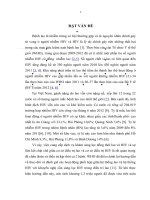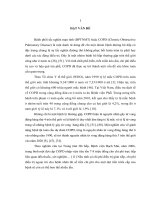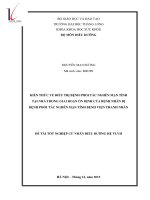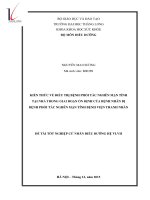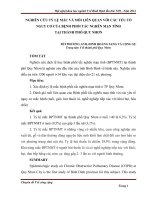THỰC TRẠNG QUẢN LÝ BỆNH PHỔI TẮC NGHẼN MẠN TÍNH TẠI BỆNH VIỆN LAO VÀ BỆNH PHỔI THÁI NGUYÊN GIAI ĐOẠN 2014 – 2018
Bạn đang xem bản rút gọn của tài liệu. Xem và tải ngay bản đầy đủ của tài liệu tại đây (318.9 KB, 6 trang )
<span class='text_page_counter'>(1)</span><div class='page_container' data-page=1>
<i>e-ISSN: 2615-9562 </i>
<b>SITUATION OF CHRONIC OBSTRUCTIVE PULMONARY DISEASE </b>
<b>MANAGEMENT IN THAI NGUYEN HOSPITAL OF TUBERCULOSIS </b>
<b>AND LUNG DISEASES PHASE 2014 - 2018 </b>
<b>Sai Minh Duc*<sub>, Hoang Ha </sub></b>
<i>TNU - University of Medicine and Pharmacy </i>
ABSTRACT
Chronic obstructive pulmonary disease is a chronic disease leading cause of death and disability.
The aim of our study was to describe the current situation of management and management of
chronic obstructive pulmonary disease at Thai Nguyen Hospital of Tuberculosis and Lung
Diseases in 2014–2018. This is descriptive study. The study found out prevalence of chronic
obstructive pulmonary disease in male patients accounted for 89.24%, 60–69 years old account for
40.18%. The patients had some related diseases including hypertension (63.29%), bronchitis
(58.22%) and diabetes (51.64%). The degree of airflow obstruction according to Global Initiative
for Chronic Obstructive Lung Disease - GOLD 2018 phase 2 was 46.4%. Human resources and
resources at the Chronic pulmonary disease Management Unit meet the standards. Good treatment
results accounted for the largest proportion with 80.04%. In summary, the model of Chronic
pulmonary disease Management Unit at Thai Nguyen Hospital of Tuberculosis and Lung Disease
in 2014-2018 finds that treatment management is stable, sustained, and sustainable.
<i><b>Keywords: Chronic obstructive pulmonary disease; Chronic pulmonary disease Management </b></i>
<i>Unit; Jam; Chronic; Thai Nguyen. </i>
<i><b>Received: 12/12/2019; Revised: 10/4/2020; Published: 29/4/2020</b></i>
<b>THỰC TRẠNG QUẢN LÝ BỆNH PHỔI TẮC NGHẼN MẠN TÍNH </b>
<b>TẠI BỆNH VIỆN LAO VÀ BỆNH PHỔI THÁI NGUYÊN </b>
<b>GIAI ĐOẠN 2014 – 2018 </b>
<b>Sái Minh Đức*<sub>, Hoàng Hà</sub></b>
<i>Trường Đại học Y Dược - ĐH Thái Ngun</i>
TĨM TẮT
Bệnh phởi tắc nghẽn mạn tính là bệnh có khả năng gây tàn phế và tử vong cao. Mục tiêu của
nghiên cứu này nhằm mô tả thực trạng phát hiện quản lý điều trị bệnh phổi tắc nghẽn mạn tính tại
Bệnh viện Lao và Bệnh phổi Thái Nguyên giai đoạn 2014–2018. Đây là nghiên cứu mơ tả. Nghiên
cứu đã tìm ra tỷ lệ bệnh nhân phổi tắc nghẽn mạn tính nam chiếm 89,24%. Nhóm 60–69 tuổi
chiếm 40,18%. Tiền sử bệnh liên quan gồm tăng huyết áp chiếm 63,29%; viêm phế quản chiếm
58,22% và đái tháo đường chiếm 51,64%. Mức độ tắc nghẽn đường thở theo Sáng kiến toàn cầu
cho Bệnh phổi tắc nghẽn mạn tính - GOLD 2018 giai đoạn 2 với 46,4%. Nhân lực, nguồn lực, vật
lực tại Đơn vị Quản lý bệnh phổi mãn tính đạt tiêu chuẩn. Kết quả điều trị tốt chiếm tỷ lệ lớn nhất
với 80,04%. Tóm lại mơ hình Đơn vị Quản lý bệnh phổi mãn tính tại Bệnh viện Lao và Bệnh phổi
Thái Nguyên giai đoạn 2014-2018 phát hiện quản lý điều trị ởn định, duy trì, và bền vững.
<i><b>Từ khố: Bệnh phởi tắc nghẽn mạn tính; Đơn vị Quản lý bệnh phởi mãn tính; Tắc nghẽn; Mạn </b></i>
<i><b>tính; Thái Nguyên. </b></i>
<i><b>Ngày nhận bài: 12/12/2019; Ngày hoàn thiện: 10/4/2020; Ngày đăng: 29/4/2020 </b></i>
<i>* Corresponding author. Email: </i>
</div>
<span class='text_page_counter'>(2)</span><div class='page_container' data-page=2>
<b>1. Introduction </b>
Chronic obstructive pulmonary disease
(COPD) is a chronic disease, very common
and has a high mortality rate in most countries
of the world. The disease is the fourth leading
cause of death and will be the third leading
cause by 2020. Around the world, there are
about 600 million people with COPD, with
the prevalence in each country ranging from
2-11% of the population and causing about
3.1 million deaths each year [1].
In Vietnam, according to the national survey
results for the years 2006-2009, the prevalence
of COPD was 4.2% in those 40 years old and
9.2% in people 65 years of age [2]. COPD is a
great burden for Vietnam's economy. COPD
patients often account for 25% of the beds in
the respiratory departments and in intensive
care units with COPD patients always on
mechanical ventilation. The application of
Global Initiative for Chronic Obstructive Lung
Disease (GOLD) at the beginning of 2002 and
the Ministry of Health treatment guidelines in
2006 has increased the attention of the early
detection and management of COPD patients
in a stable period.
The Division of Chronic Lung Disease
Management (CMU) of Tuberculosis and
Thai Nguyen Lung Disease Hospital has been
deployed since October 2014, now more than
5 years of organizing, managing and
receiving patients with lung disease Chronic
obstruction from the city and neighboring
districts. There is currently no study on
management and treatment of EP in here and
Thai Nguyen province.
Therefore, in order to understand the process
of management and treatment of chronic
obstructive pulmonary disease we conducted
<i>research with the goal to describe the current </i>
<i>situation of chronic obstructive pulmonary </i>
<i>disease </i> <i>management </i> <i>in </i> <i>Thai </i> <i>Nguyen </i>
<i>Tuberculosis and Lung Hospital 2014-2018. </i>
<b>2. Subjects and research methods </b>
<i><b>2.1. Subject, time, place of research </b></i>
- Medical records (MR), books, archived data
on management and treatment of COPD
patients at CMU unit of Tuberculosis and
Thai Nguyen Lung Disease Hospital from
October 10, 2014 to October 10, 2018.
- Selection criteria:
+ COPD patients were managed and treated at
CMU unit from October 2014 to October
2018 according to the medical records.
+ From the age of 18 or older.
+ Having MR to record all information
content as prescribed by the CMU unit on the
management of MR of the patient.
- Exclusion criteria: not meeting the above
selection criteria.
<i><b>2.2. Research method </b></i>
- Descriptive research method Cross-sectional
design.
<i><b>2.3. Sample size and sampling technique </b></i>
- Sample size: Complete
+ Intentional sampling: selection of all
medical records, records, books, and data on
management and treatment of COPD patients
at Thai Nguyen Tuberculosis and Lung
Disease Hospital from 2014-2018.
<i><b>2.4. Research targets </b></i>
- General characteristics of COPD patients.
- The human and material resources of CMU.
- Indicators on detection and management.
- Indicators of treatment results.
<i><b>2.5. Some concepts used in research </b></i>
<i>2.5.1. History of related illness </i>
- Related diseases of COPD patients have
been published from previous domestic and
foreign scientific research results.
- Related diseases include: Hypertension,
diabetes, bronchitis, bronchial asthma,
tuberculosis, stomach ulcers, osteoarthritis,
kidney failure, cancer, ...
</div>
<span class='text_page_counter'>(3)</span><div class='page_container' data-page=3>
<i>2.5.2. Distribution of airflow obstruction according to GOLD 2018 (See Table 1) </i>
<b>Table 1. </b><i>Distribution of airflow obstruction according to GOLD 2018 </i>
<b>GOLD stage </b> <b>FEV1 value after bronchodilator rehabilitation test </b>
Phase 1 FEV1 ≥ 80% of the theoretical value
Phase 2 50% ≤ FEV1 <80% of the theoretical value
Phase 3 30% ≤ FEV1 <50% of the theoretical value
Phase 4 FEV1 <30% of theoretical value
<i>2.5.3. A general treatment regimen at CMU can be expressed as following: </i>
- Stop contact with risk factors
- Withdrawal from tobacco, pipe tobacco
- Vaccination against respiratory infections
- Rehabilitation of respiratory function
- Other treatments
- Medicines to treat chronic obstructive pulmonary disease are being used at CMU.
<b>Drug class </b> <b>Abbreviations </b> <b>Active </b>
Intensive beta 2 adrenergic effect is short SABA Salbutamol, Terbutaline
Intensive beta 2 adrenergic effect LABA Indacaterol, Bambuterol
Short-acting anticholinergics SAMA Ipratropium
Long-acting anticholinergics LAMA Tiotropium
Intensive beta 2 adrenergic short-acting + short-acting
anticholinergic
SABA+SAMA Ipratropium/salbutamol
Ipratropium/fenoterol
Intensive beta 2 long acting adrenergic + long acting
anticholinergic
LABA/LAMA Indacaterol/Glycopyronium
Olodaterol/Tiotropium
Vilanterol/Umeclidinium
Inhaled corticosteroid + beta adrenergic beta 2 long acting ICS+LABA Budesonid/Formoterol
Fluticason/Vilanterol
Fluticason/Salmeterol
Antibiotics, anti-inflammatory Macrolide
Anti PDE4
Erythromycin
Rofumilast
The short/ long acting xanthine group Xanthine Theophyllin/Theostat
<i>2.5.4. Treatment results </i>
- The good and bad treatment results of
COPD patients have been published from
domestic and foreign scientific research
results.
- Good treatment results include: Stable
disease stage, reduced dyspnea, good
response to treatment, ...
- Bad treatment results include: Increasing the
stage; including mechanical ventilation;
referral, unresponsive to treatment, ...
- Source of information on treatment results:
Information from the patient's medical
records.
<i><b>2.6. Data collection techniques </b></i>
- Collect secondary data from medical
records, books, and data on management and
treatment of COPD patients in prepared
survey questionnaires that meet the research
criteria.
<i><b>2.7. Methods of data processing </b></i>
- Medical statistics: coding and inputting data
into computers and processing on SPSS 16.0
software.
<i><b>2.8. Ethical research </b></i>
</div>
<span class='text_page_counter'>(4)</span><div class='page_container' data-page=4>
approved by the ethics council of Thai Nguyen University of Medicine and Pharmacy.
<b>3. Results and discussion </b>
<i><b>3.1. Some common features of COPD patients at CMU from 2014-2018 </b></i>
<i><b>Table 2. Some common features of COPD patients </b></i>
<b>Characteristics </b> <b>Amount (n = 1125) </b> <b>Ratio (%) </b>
<b>Sex </b> Male 1004 89.24
Female 121 10.76
<b>Age group </b>
18-39 6 0.54
40-49 257 22.84
50-59 311 27.64
60-69 452 40.18
70 99 8.80
<b>History of related </b>
<b>illness </b>
Asthma 253 22.48
Bronchitis 655 58.22
Tuberculosis 72 6.40
Diabetes 581 51.64
Hypertension 712 63.29
Table 2 presents some common features of
COPD patients as below.
<i>Gender characteristics: The ratio of male/ </i>
female COPD patients was 1004/121. Our
results are higher than the results of some
domestic authors. For instance, the study of
Dinh Ngoc Sy in 2011 revealed that COPD
patients were 7.1% male and 1.9% female [3];
Tran Thi Ly (2019) stated that the proportion
of men accounted for 76.6% and women
accounted for 23.4% [4]. Studies have shown
that COPD is more common in men.
<i>Age group characteristics: Our study of 1125 </i>
patients showed that the average age of
patients was 61.8 (95% CI = [58.1 - 65.9])
Our results are similar to the results by some
domestic authors such as Vu Duy Thuong
(2008) with an average age of 67.7±6.8 [5].
<i>History of related illness: COPD patients in </i>
this study had some related diseases such as
bronchitis, diabetes and hypertension.
Domestic studies mainly mention
co-morbidities on COPD patients. For example, in
the study of Tran Thi Ly (2019), the incidence
of hypertension was 40.3% [4]; Luong Quang
Thai (2014) found the incidence of
hypertension accounted for 67.94% [6];
Nguyen Hoai Bac (2019) revealed the
incidence of bronchitis was 55.6% [7].
The study results in Table 3 show that
patients were primarily identified in stage 2
with 46.4% and stage 3 with 23.5%. Phase 1
accounts for 19.7%. This result is similar to
many domestic studies such as Nguyen Hoai
Bac (2019) with phase 2 of 30.4% and phase
3 of 29.2% [7]; Le Van Anh et al (2006)
subjects of stage 2 accounted for 55.9% and
phase 3 accounted for 32.8% [8].
<i><b>Table 3. Distribution of airflow obstruction rates </b></i>
<i><b>according to GOLD 2018 </b></i>
<b>Patient </b>
<b>Stage </b> <b>Amount </b>
<b>Ratio </b>
<b>(%) </b>
Phase 1 211 19.7
Phase 2 522 46.4
Phase 3 265 23.5
Phase 4 117 10.4
Total 1125 100
This result shows that people need to be cared
more about their health. When abnormal
health signs appear, especially respiratory
abnormalities, it is necessary to have health
check in order to detect diseases in time, in
early stage in order to be prevented and
treated effectively.
<i><b>3.2. Actual situation of human resources, </b></i>
<i><b>resources and material resources of CMU </b></i>
</div>
<span class='text_page_counter'>(5)</span><div class='page_container' data-page=5>
X-ray machine, biochemical and hematology
tests, nebulizer, etc. have been fully ensured
and helped to well operate medical
examination and treatment activities. Along
with regular training for medical examination
and treatment activities is always the best,
human resources always meet the requirements
of professional knowledge. With human
resources, material resources on CMU over 5
years of effective operation have met the
functions of management and treatment tasks
appropriate to the number of patients.
<i><b>Table 4. Description of human resources, </b></i>
<i>resources and resources of CMU at the </i>
<i>Sustainable Development and Development </i>
<i>Department 2014-2018 </i>
<b>Result </b>
<b>Element </b> <b>Amount </b>
CMU unit 01
Doctors 01
Nursing 01
Test technician 11
Technician measure the machine 01
Medical table and chair 05 set
Medical examination kit 04 set
Means of clinical examination Full
Respiratory function meter 04 set
Nebulizer 04 set
Essential medicine Full
X-ray 02 machine
ECG 02 machine
CT-scanner 01 machine
Biochemical - hematology meter 01 set
Ultrasound machine 01 machine
<i><b>3.3. Management results of CMU in the </b></i>
<i><b>period of 2014-2018 </b></i>
From the results in Figure 1, we found that:
The number of people with COPD over the
years from 2014-2018 tended to decrease,
particularly in 2018 compared to 2016,
decreased by 5.51%, compared to 2015 was
3.56 %. The number of patients decreased due
to the fact that in 2017 and 2018, the
management of COPD treatment has been
increased at Thai Nguyen Central Hospital,
some districts in the province such as Phu
Binh, Phu Luong, Dong Hy... started
implementing the CMU model, reduce the
number of patients (2017 decreased 9.24%
compared to 2016). However, the number of
patients infected in 2018 increased by 3.73%
compared to 2017. The increase and decrease
here is not too big change.
18.22[ 22.67[ 24.62[
15.38[
20
30
40
50
60
70
80
90
100
<i><b>Figure 1. Discovering and managing COPD </b></i>
<i>patients during 2014 - 2018 </i>
The trend of COPD does not have any data
showing that chronic obstructive pulmonary
disease will decrease in the near future. In
contrast, most studies and forecasts indicate
that due to increased environmental pollution
in the near future, COPD continues to tend to
increase [4]. Looking at Figure 1, we can see
that since the establishment of CMU in
October 2014, the management of detection
has been maintained continuously over the
years, this is very necessary to promote. The
stability shown by the number of patients
over the years does not change, large
fluctuations show the effectiveness of this
management model, need to maintain this
stability. The sustainability of the model
reflected in the performance is maintained
continuously. This is a strong point when
synchronous management of COPD patients
at CMU units, it is necessary to continue to
promote and maintain the effectiveness as
above at CMU Thai Nguyen.
</div>
<span class='text_page_counter'>(6)</span><div class='page_container' data-page=6>
mechanical ventilation, increased stage,
referral, no response to treatment,...)
accounted for 19.96%; severe accounted for
16.53% and death accounted for 3.43%.
<i><b>Table 5. Management and treatment results of </b></i>
<i>COPD at Thai Nguyen Tuberculosis and Lung </i>
<i>Hospital period 2014-2018 </i>
<b>Evaluate </b>
<b>Result </b> <b>Amount </b> <b>Ratio (%) </b>
Good 904 80.04
Bad Heavy 186 16.53
Dead 35 3.43
This result is similar to the studies on
management and treatment of COPD in
Vietnam according to the guidelines, followed
by a short-tracked guideline (usually over 1
year) showing good treatment effect [9]. The
results show that the management and
treatment activities here were being
implemented very well, the number of
patients treated over 5 years accounts for the
majority of good rates, this is a positive result
of the management and treatment of the
disease. Pulmonary congestion in Thai
Nguyen need to continue to maintain,
promote this effect.
<b>4. Conclusion </b>
Researching the current situation of chronic
obstructive pulmonary disease management at
the Sustainable Development Center for the
period 2014-2018 we draw some conclusions
as follows:
- About general characteristics of patients
with COPD: The majority of patients were
male, accounting for 89.24%. Age was
mainly from 60-69 years old accounted for
40.18%. The rate of stage 2 infection was
46.4%. History of related diseases was
mainly hypertension (63.29%), bronchitis
(58.22%), diabetes (51.64%).
- The reality of human resources and material
resources of CMU met well the functions and
tasks of detecting, managing and treating
chronic lung diseases in the management area.
- About management findings: the CMU
model shows the stability and sustainability of
management and treatment of patients with
COPD, which should maintain the
effectiveness of this model.
- About treatment management results: The
rate of good results accounts for 80.04%, and
bad results account for 19.96%.
REFERENCES
[1]. Global Initiative for Chronic Obstructive
<i>Lung Disease (GOLD), Global strategy for </i>
<i>diagnosis, management and prevention of </i>
<i>chronic </i> <i>obstructive </i> <i>pulmonary </i> <i>disease, </i>
revised, 2018.
<i>[2]. N. S. Dinh et al., Epidemiology of chronic </i>
<i>obstructive pulmonary disease (COPD) in </i>
<i>Vietnam and preventive and therapeutic </i>
<i>measures, </i> National project code
KC.10.02/06- 10, 2010.
[3]. N. S. Dinh et al., “Situation of asthma and COPD
in Vietnam,” National Conference on
Tuberculosis and Lungs in Can Tho, June 2011.
[4]. T. L. Tran, "Situation and effectiveness of
using management and care services for
people with chronic obstructive pulmonary
disease and asthma in some units of chronic
lung management in Vietnam," PhD thesis,
Hanoi Medical University, 2019.
[5]. D. T. Vu, “Clinical epidemiological study of
chronic obstructive pulmonary disease in Vinh
city - Nghe An”, Master's thesis in Medicine,
Hanoi Military Medical Academy, 2007.
[6]. Q. T. Luong, “Research on clinical and
subclinical characteristics in patients with
coronary artery disease with chronic
<i>obstructive pulmonary disease”, Journal of </i>
<i>Scientific Research, No. 42, pp. 78 - 81, 2014. </i>
[7]. H. B. Nguyen, “Epidemiological
characteristics and effectiveness of
interventional intervention of EP in two
districts of Bac Ninh province,” PhD thesis,
Thai Nguyen University of Medicine and
Pharmacy, 2019.
[8]. V. A. Le, “Epidemiology, Clinical, pulmonary
ventilation of chronic obstructive pulmonary
disease in Bac Giang city”, Graduated thesis
of Level 2, Hanoi Medical University, 2006.
[9]. V. N. Nguyen, "Implementation of GINA
</div>
<!--links-->


